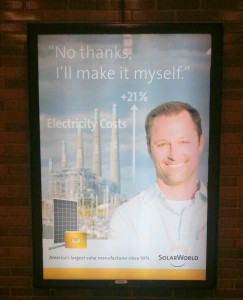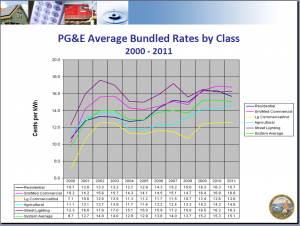SolarWorld Electic Rate Hike Lie
According to the CPUC, this SolarWorld billboard, which I saw at Civic Center station BART last night, is a lie created by lying liars.
The historical electric rate chart at the CPUC says that average electric rates have gone from 13.8 cents per kWh to 15.1 cents per kWh, that is a 9% increase. The sign indicates a 21% increase from 2006 to 2011.
Find the CPUC historical rate chart here. Local archive.
Honestly, I don’t have it in for SolarWorld. I just have it in for getting facts right. They could have made a compelling argument with the data at hand, but they chose to lie instead.


Average rate percentage increase vs. observed rate percentage increase. These may both be facts. It depends entirely on how PG&E decides to incentivise conservation.
Average rate percentage increase vs. observed rate percentage increase. These may both be facts. It depends entirely on how PG&E decides to incentivise conservation.
Corey can you elaborate?
Update: PGE.com has a slightly different story but it’s hard to tell exactly…
Look at PG&E’s historical rates page. Compare the “average” rate from Residential (JAN 1, 2006 – FEB 28, 2006) (15.439 cents) and the average rate from Residential (JAN 1, 2011 – FEB 28, 2011) (18.166 cents) and you get a 16 percent rate increase, which is closer to SolarWorld’s 21%. It is conceivable that SolarWorld is talking about a different rate hike for homes that use a lot of electricity, but they don’t mention it on the billboard and I haven’t been able to find stats for that.
Electric rate increases only justify a solar install if you’re terrible at math. There are many good reasons to install solar but saving money on power is simply not one of them! At 15c / kW/h, a $700 panel getting full sunlight for 6 hours a day will pay for itself in about 27 years. That’s longer than the expected life of the panel. And that doesn’t even include the rest of a solar system or the install.
Rich its a little better than that. Lets say a $700 panel generates 200 Watts.
200 Watts * 6 hours = 1.2 kW he’s per day.
1.2 kW hrs * $0.15 = $0.18 per day
$700 / $0.18 = 3888 day payback
3888 / 365 days in a year = 10.6 years to payback
So a panel should pay for itself in 10.6 years (not counting lots of other expenses). Panels have proved themselves to last 30 years and more.
If you are on the grid with no subsidies, solar doesn’t pay for itself. If you are in a unique circumstance (like off the grid or really expensive electricity) or if somebody gives you free money (ie federal and state subsidies ) then solar can be cost efficient!
I was basing that on a 80 watt panel, but they cost less than that. The almost $700 panel I saw was 120 watt. Maybe you can get a 200 watt panel for that I have not seen one. Still, it just does not compete on price. Like I said, many many good reasons to do it but not $/kWh.
PG&E incentives conservation by lowering price per kilowatt to people who use less than average amounts of power or utilize power around peak hours. Therefore, residents or businesses who have heavy utilization, especially during business hours, get charge for power at a higher than average rate.
It is possible that the person who observed this high charge would benefit GREATLY from offsetting grid usage during peak hours with supplemental solar systems. At this point, utilizing solar WILL pay for its self. Especially since peak usage, especially in the summer, is experienced during the heat of the day. If a business can, in essence, pay for air-conditioning with solar power, they will pay for less electricity during peak hours and the power they pay for will be charged at a lower rate.
Rich, I just found 235 watt Kyocera (a good brand name) panels for $570 (http://www.wholesalesolar.com/solar-panels.html). Groovy. I agree that solar panels don’t compete well with grid power, but I still contend that they are pretty close. If the price of coal power tripled, solar power would definitely be cost competitive. And eventually that’ll happen.
Corey, in California, the best closest PG&E has to the kind of plan you are talking about are the time-of-use plans. It’s possible to make them work but it’s tricky (way trickier than SolarWorld’s claim of “electric rates have climbed 21% since 2006”) The time-of-use plans get tricky because, well, for example, to make it work for a residential customer, they need to be in an area that needs air conditioning and they need to be home during the day using a lot of electricity… using electricity in tier 4 a lot.
(followup to Corey) it can work better for a business, becuase they often have a big roof, and use elecricity during the day, but they need to own the building and they need to want to put a lot of money onto the roof. Most businesses don’t operate on savings, they operate on debt, so it’s tricky.
….waaaay trickier than SolarWold’s lying billboard.
I don’t think you can say they are lying given the fact that we don’t know the volume of energy the “client” in question was using. There is a sufficiently variable charging system to allow what was posted in the advertisement to be considered valid.
Please note that the chart you linked to STATES “average”. That pretty much sums up my arguement.
Corey, that’s why ads have little stars like this* next to the print. Then in tiny print it explains all the caveats. Let me quote from the Federal Trade Commission: (http://business.ftc.gov/documents/bus35-advertising-faqs-guide-small-business)
Under the Federal Trade Commission Act:
Advertising must be truthful and non-deceptive;
Advertisers must have evidence to back up their claims; and
Advertisements cannot be unfair.
Their ad has a graphic titled “Electricity Costs. It starts at 2006 and goes to 2011 and reads “+21%”. There is nothing else in the ad. Unless they qualify their claim, they are liars. That pretty much sums up my argument
On another note, its exciting to see the company Nanosolar claims to be making a $0.40 per watt solar panel. So that $700 240 watt panel might soon cost $100. They seem to be scaling their company up nicely and it’s got good backing. I’m still skeptical but that could bring solar and coal pretty close to parity financially. I don’t think it’ll be -at- parity, but close!
Charlotte’s brother Robert pointed out as we passed another one of those billboards yesterday, “Maybe the guy in the picture used to be homeless but he isn’t any more. So now he’s got to pay for things like light and heat. His new electric bill is a good thing!”
Not sure how I came across this dumb blog – but Lee, this is no lie.
Get your pricing and electrical figures right before you jump on your little soap box.
PS – did you really blog about an ad? get a life!
Biff, if you believe my information is in error, please offer a correction. If you can’t point out how I am incorrect, I will assume the CPUC and PG&E data is correct.
PS. You are a dumb dummy of a doo doo head.
Ah, I see how name calling can make one feel superior; thanks!